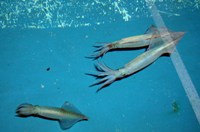Why small males have big sperm

Male squid (Loligo bleekeri)
10 August 2011
Paul Shaw, Professor of Population Genetics & Genomics at IBERS has published research findings into the evolution of mating strategies in squid. In 2008, whilst at Royal Holloway University of London, he set up a research collaboration with scientists in Japan as part of a larger global network involving groups in the UK, South Africa, Japan, California and Australia, to investigate squid (and other cephalopod) reproduction across the world.
Alongside the researchers in Japan, he looked at the sperm produced by small sneaker males and large consort males and discovered that the sperm produced by the sneaker males was significantly larger than that of the consorts, the first time that such a difference in sperm size has been observed in any animal.
Dr Yoko Iwata from University of Tokyo said, “Sperm size is likely to be an adaptation to fertilisation environment, either inside the female or externally, rather than competition between sperm, because the fertility and motility of sneaker and consort sperm were the same.”
Male squid (Loligo bleekeri) employ different reproductive strategies depending on their body size. Research published in BioMed Central’s open access journal BMC Evolutionary Biology, shows that the divergent mating behaviour of male squid has resulted in the evolution of different sperm sizes.
Large male squid compete for females by courting them with flashy skin colour-change displays. Once a female has chosen her partner they mate in an above and below position so that the male can place his sperm inside the female’s oviduct. He remains with the female until she spawns, ensuring that his sperm fertilise her eggs and that no other males have a chance to mate with her. At the moment a female lays her eggs, small ‘sneaker’ males rush in and mate with her, head to head. These small males place packages of sperm by the female’s mouth in the hope that their sperm have a chance of fertilising the eggs as she holds them in her arms before laying them on the sea bed.
Paul commented: “My research interests lie in understanding the distribution and evolution of genetic biodiversity within species, particularly in aquatic systems. The aim is to define mechanisms underlying population evolution and speciation, and how biodiversity can be protected, and all these elements underpin this very revealing research.” Prof Shaw is continuing this work within a major investment in IBERS as part of the Biosciences, Environment and Agriculture Alliance (BEAA)
Overall, the larger males’ strategy resulted in higher paternity rates - but for smaller males, who cannot win a female by fair means, being sneaky and having bigger sperm gives them a chance of passing on their genes.
AU19111



